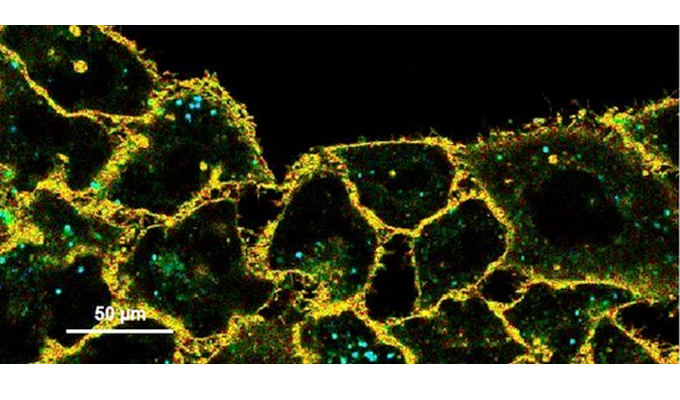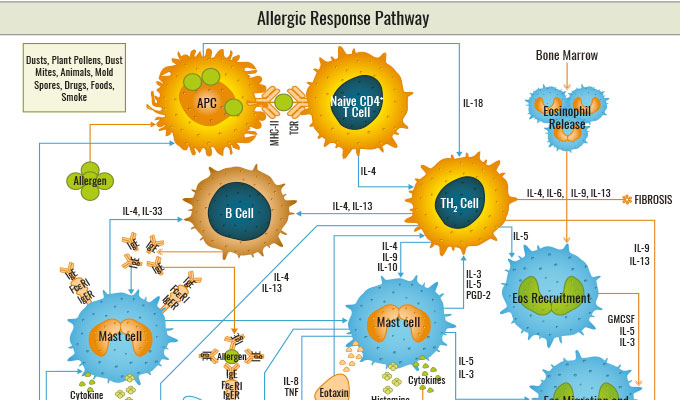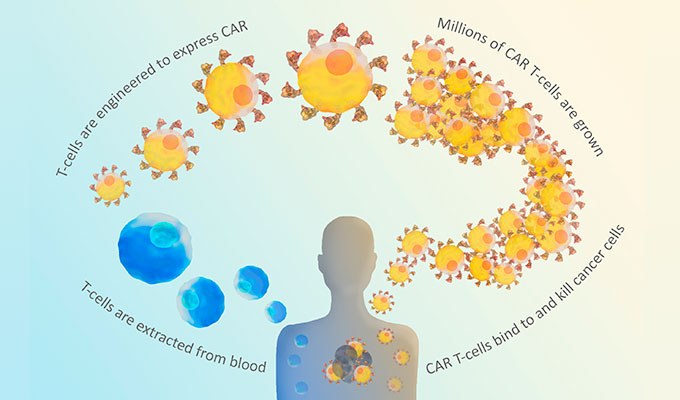Recent articles have highlighted the role the STING cell signalling pathway may be playing in drug development, whether via its inhibition to control innate immunity and inflammation (Nature Biotechnology, March 2019 : “Drug developers switch gears to inhibit STING”), through activation of STING to boost checkpoint inhibitors in their fight against cancer (C&EN 2018 “STING fever is sweeping through the cancer immunotherapy world”), or using STING ligand cGAMP as a vaccine adjuvant for anti-tumour or anti-viral vaccines. More specifically, Aduro has demonstrated how their compound ADU-S100 activates the STING pathway to increase immune reponse against cancer cells. This interesting interview on their clinical trials program (AACR 2016) relates its potential synergy with immune checkpoint inhibitors and potent effect in systemic tumour regression.
How does the STING pathway work? And which tools can be of help to study its potential activation or inhibition is what this post aims to illustrate.
STING pathway: A bit of background
When DNA (either extrinsic DNA like viral or bacterial DNA, or intrinsic DNA like tumour derived DNA) is exposed in the cytoplasma, cGAS (cyclic GAMP-AMP synthase) binds to it and degrade DNA into smaller GMP-AMP units (cGAMP). cGAMP acts as second messenger to activate the STING pathway.
What exactly is STING?
STING is an endoplasmic reticulum signaling protein (also known as TMEM173) with an important role in the defense against virus and intracellular bacteria via the regulation of TYPE I interferon innate immunity (non-specific defense mechanisms that come into play immediately or within hours of an antigen’s appearance in the body).

STING binds to cyclic dinucleotides, or facilitates their interaction with cytosolic kinase TBK1, and induces activation of IRF3 and STAT6.
STING has also been involved in inflammatory responses related to cancer (colon, gastric, lung), severe auto-immune responses when inappropriate responses to cytosolic nucleic acid occur and are of interest in immuno-oncology where a defective STING activation can lead to diminished IFN responses.
This explains why STING activators and inhibitors are subject to recent research projects, activators in patients where it is defective (direct injection of STING activators in tumors), or inhibitors to control systemic inflammation. Activators (or agonists) like 2’, 3’ cGAMP induce autophagy, for clearance of DNA and viruses in the cytosol. Inhibitors such as C-176 result in the decrease of systemic inflammation via a reduction in IFN Type I levels.
STING pathway-related reagents
STING Activators and Inhibitors
As either activation or inhibition of STING can be of interest in modulating innate immune responses, several STING specific activators and inhibitors are listed below to provide you with some internal controls for your research:
- Agonists : DMXAA, 2’, 3’ cGAMP, Alpha-Mangostin
- Inhibitors : H-151, C-176, C-178
cGAMP measurement tools
An interesting newly released kit by Arbor Assay allows cyclic GAMP measurement. You will find detailed information about this unique kit in a previous post I wrote on it.
IFN Type I quantification
STING activation or inhibition has a direct impact on IFN type I expression levels. Having access to sensitive and robust assays to measure type I IFN alpha and beta is a bonus in a market where multiple ELISA kits are released. The ELISA references below are produced by PBL Assay Science, an Interferon specialist for immunoassays, recombinant proteins, and antibodies.
- Interferon Alpha ELISA (41115-1)= High sensitivity assay for all subtypes; reproducible results with <10% inter- & intra-assay CVs; especially recommended for difficult matrices (auto-immune sera)
- Inteferon Beta ELISA (41415)-1 for accurate IFN Beta measurement in serum and plasma (including from auto-immune diseases)
Phosphoassays for STING pathway signalling proteins
You may wish to look at the proteins involved in the STING signalling cascade, compare their phosphorylated forms versus total proteins levels, in cell and tissue lysates or in adherent cells. Depending on your application, the kits that I present below may be of interest to you. I have highlighted the phosphorylation sites they detect and sample type they can accommodate.
For STAT6
- PEL-STAT6-Y641-1 semi-quantitatively measures STAT6 phosphorylated at Tyrosine-641 in lysate samples
- PEL-STAT6-Y641-T-1recognizes Human STAT6 phosphorylated at site Tyrosine-641 as well as total STAT6 in Cell and Lysates
- PEL-Stat6-Y-1 : recognizes Human Tyrosine-Phosphorylated-STAT6 in cell and tissue lysates
- CBEL-STAT6-1 Human/Mouse Phospho-Stat 6 (Y641) : this Cell-based assay recognizes human and mouse Stat 6 phosphorylated at site Tyrosine-641 and total Stat 6 for comparison in adherent Cell Culture
For STAT3
- CBEL-STAT3-1 : recognizes human, mouse and rat Stat 3 phosphorylated at site Tyrosine-705 and total Stat 3 for comparison in adherent cultures
- PEL-Stat3-Y705-1 semi-quantitatively measures human, mouse, rat phosphorylated Stat 3 (Tyr705) in lysate samples
- PEL-Stat3-Y705-T-1 recognizes human, mouse and rat Phospho-Stat3 (pTyr705) + pan Stat3 in cell and tissue lysates
For IRF3

- PEL-IRF3-S386 semi-quantitatively measures IRF-3 phosphorylated at Serine-386 in lysate samples
- PEL-IRF3-S386-T-1 semi-quantitatively measures IRF-3 phosphorylated at Serine-386 as well as total IRF-3 in lysate samples
TBK1
- PEL-TBK1-S172-T-1: Human, Mouse and Rat Phospho-TBK1 (Ser172) and Total TBK1 ELISA Kit. This assay semi-quantitatively measures TBK1 phosphorylated at Serine-172 as well as total TBK1 in cell lysate samples
- PEL-TBK1-S172-T-1: Human, Mouse and Rat Phospho-TBK1 (Ser172) and Total TBK1 ELISA Kit. This assay semi-quantitatively measures TBK1 phosphorylated at Serine-172 as well as total TBK1 in cell lysate samples
Is the STING cell signalling Pathway a crucial player in future immunotherapy strategies? I don’t know. It has generated quite a lot of interest lately and brought some interesting perspectives in immuno-oncology. If you are working in the domain, the tools I have presented in this post could be of interest to you. Feel free to contact me if you can’t find here what you are looking for, I’ll be happy to help.



